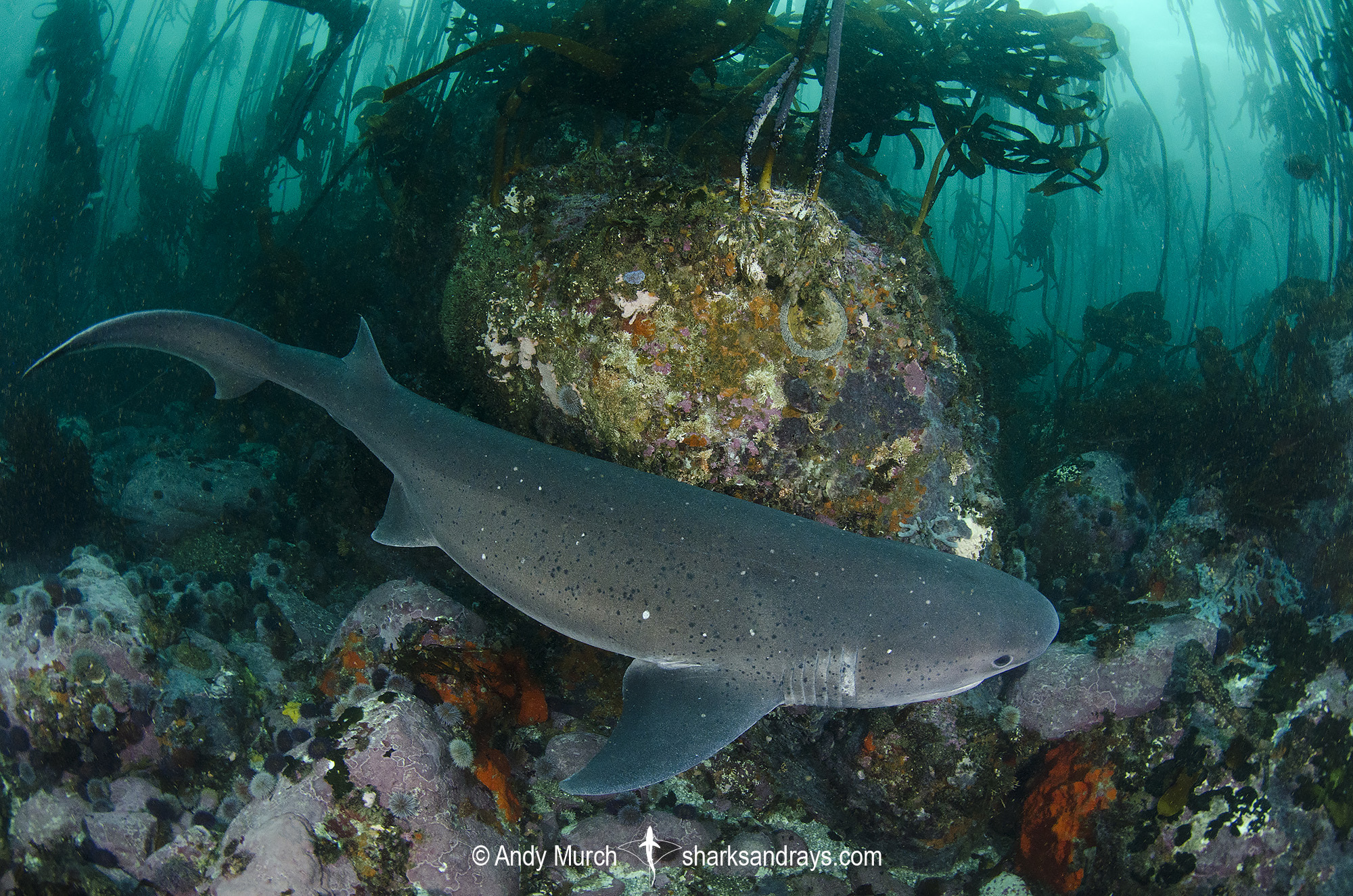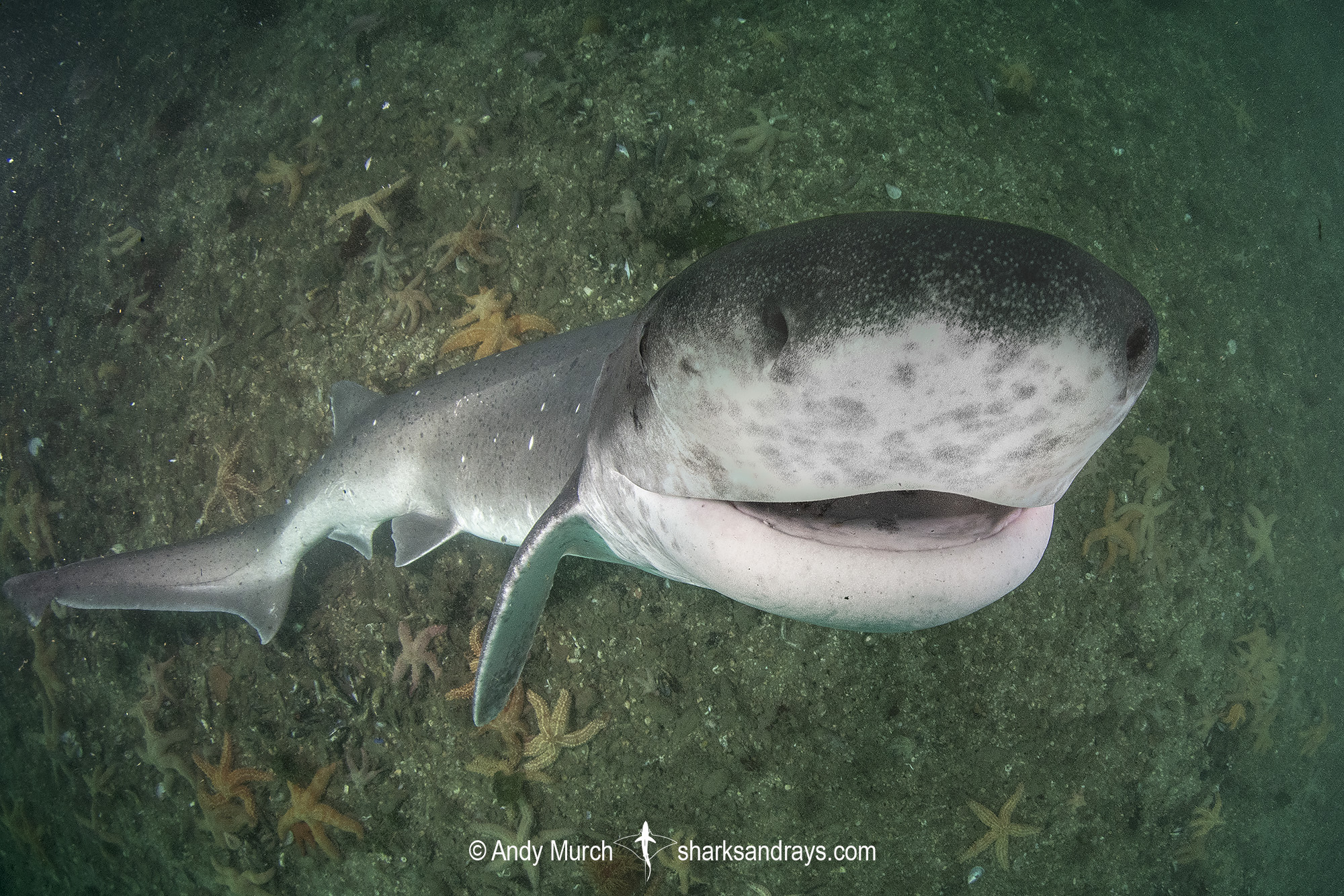Common names
Broadnose Sevengill Shark.
Binomial
Notorynchus cepedianus.
Synonyms
Heptanchus indicus, Heptanchus pectorosus, Heptrachias pectorosus, Heptranchias cepedianus, Heptranchias haswelli, Heptranchias pectorosus, Heptranchias spilotus, Notidanus ferox, Notidanus indicus, Notidanus medinae, Notidanus wolniczkyi, Notorhynchus borealis, Notorhynchus cepedianus, Notorhynchus maculatus, Notorhynchus ocellatus, Notorhynchus platycephalus, Notorynchus indicus, Notorynchus macdonaldi, Notorynchus maculatum, Notorynchus maculatus, Notorynchus pectorosus, Notorynchus platycephalus, Squalus cepedianus, qualus platycephalus.
Identification
A large bodied cow shark with a short, rounded snout. Seven gill slits. Six fairly broad, sawlike teeth on each side of the lower jaw. Single dorsal fin. Dorsal origin level with (or anterior to) free rear tips of pelvic fins. Caudal fin has an indistinct lower lobe. Upper caudal lobe deeply notched. Dorsal coloration grey or grey-brown with many scattered dark grey spots and blotches and a few white spots and blotches. Spot pattern may be quite dense completely absent. Ventral coloration may be light grey or mottled white and grey.
Size
Maximum length 296cm. Size at birth 34-45cm.

Conservation Status
VULNERABLE
The Broadnose Sevengill Shark (Notorynchus cepedianus) is targeted and a bycatch species in deep-water industrial, artisanal, and recreational fisheries. Three genetically distinct populations exist without significant interbreeding across the oceanic basins, increasing vulnerability to localized depletion. The Broadnose Sevengill Shark is suspected to have undergone a population reduction of 30–49% since the 1950s.

Habitat
A temperate water species inhabiting kelp forests and sandy or rocky bays. Found from the surface to at least 136m but usually in shallow water.
Distribution
The broadnose sevengill shark is wide ranging along temperate coastlines. It is found along most temperate coastlines in the southern hemisphere. In the northeast Pacific it has been recorded from British Columbia to Baja, and the northwest Pacific from Korea to Taiwan including Japan. Records from Sri Lanka and India are probably misidentifications. Absent from the North Atlantic.
Reproduction
An aplacental viviparous species. Litter size poorly known but clearly very large; one specimen contained 82 near term embryos.
Diet
Feeds on sharks and rays, bony fishes and marine mammals (pinnipeds). In turn, sevengill sharks predated upon by orcas and white sharks.
Behavior
A slow moving species that patrols kelp forests, rocky reefs and mud flats. Sevengills in Humboldt Bay, California have been observed foraging on shallow mud flats before dawn, returning to deeper channels at sunrise.
In False Bay, South Africa, many sevengills (often juveniles) remain in the kelp forest. As well as providing an abundant supply of food, the forests likely act as cover from great white sharks; a species that rarely ventures into kelp. However, in False Bay I have also seen sevengill sharks far away from the forest, on a baited camera left on open sand at ~50m.
At one particular kelp stand in False Bay where sevengills were especially abundant, in 2018, a sevengill carcass was found on the sea floor with tooth marks that indicated an attack by orcas. Since that time, sevengills have been mostly absent from that specific area.
Reaction to divers
When encountered in kelp forest, broadnose sevengill sharks often seem oblivious to divers until they are extremely close (1-2m away), at which point they usually explosively accelerate, but soon resume their normal slow swimming speed. It is tempting to think they don’t see divers but as apex predators that consume seals and fast moving sharks, they probably have excellent eyesight.
CAUTION: In baited situations, sevengills usually become very aggressive. Not only will they persistently turn towards divers and attempt to bite, but they also approach from above and below, making the process of redirecting them rather difficult when multiple sharks are present.
Diving logistics
There are a number of places where broadnose sevengill sharks are regularly encountered by divers.
Historically, Millers Point in False Bay, South Africa, was an excellent spot to see sevengills until a predation event (probably from an orca) took place a few years ago. Since then the sevengills have been thin on the ground but they still show up on occasion. During our (Big Fish Expeditions) South African Endemic Shark Diving Expeditions, we always conduct a few lightly-chummed dives either in the kelp forest or within the harbour at Simonstown. Invariably, sevengill sharks show up, so the sharks are clearly still in the area.
In the eastern Pacific, Divers at La Jolla Cove near San Diego, often encounter sevengills patrolling the kelp forests. The encounters are hit and miss but a few days of diving in mid/late summer will likely be rewarded with an encounter. La Jolla Cove is a very popular shore diving spot, so arrive early to avoid a very long schlepp with heavy dive gear!
In Bahia Bustamente in Patagonia, kelp harvesters regularly encounter sevengills within the kelp forest. There is a hotel at the ‘kelp farm’ but no diving infrastructure, so divers will need to drive down from Puerto Madryn with all personal equipment and a supply of tanks.
Further south at Ria Deseado, a hotel owner told me that he also sees sevengills while diving but this area is even further away from the nearest diving infrastructure.
Sevengills are also seen on occasion by divers around the south island of New Zealand. A 2015 Shark Week ‘documentary’ entitled Sharks of the Shadowlands sensationalized the encounters where sevengills have apparently harassed divers that were removing invasive kelp from local reefs.
Similar species
Bluntnose Sixgill Shark Differentiated by having six gill slits instead of seven, and lack of significant markings. Although sevengills have been recorded in BC where sixgills are found in shallow water, there are no records of sevengill encounters by divers that far north.
Sharpnose Sevengill Shark Differentiated by it’s small size (<1m), pointed snout, much larger eyes, and lack of spots. This species rarely enters shallow water.




















